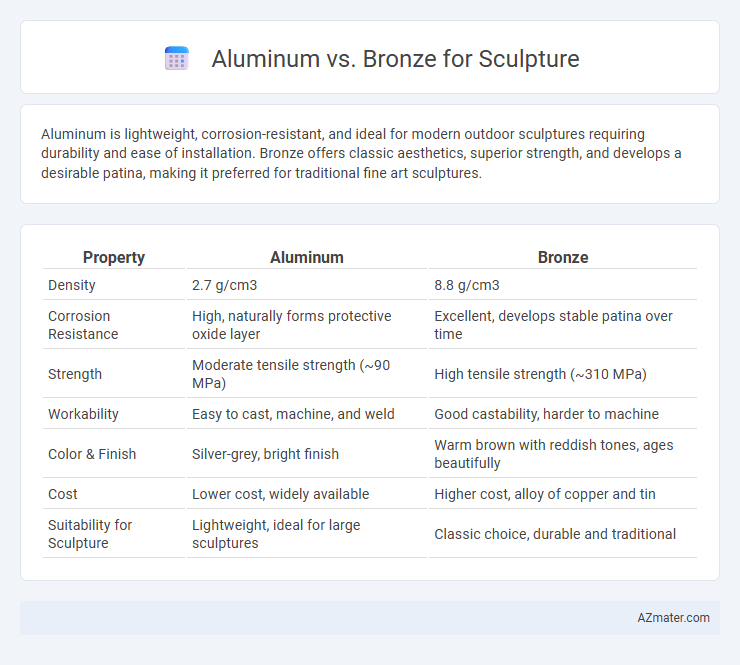Aluminum is lightweight, corrosion-resistant, and ideal for modern outdoor sculptures requiring durability and ease of installation. Bronze offers classic aesthetics, superior strength, and develops a desirable patina, making it preferred for traditional fine art sculptures.
Table of Comparison
| Property | Aluminum | Bronze |
|---|---|---|
| Density | 2.7 g/cm3 | 8.8 g/cm3 |
| Corrosion Resistance | High, naturally forms protective oxide layer | Excellent, develops stable patina over time |
| Strength | Moderate tensile strength (~90 MPa) | High tensile strength (~310 MPa) |
| Workability | Easy to cast, machine, and weld | Good castability, harder to machine |
| Color & Finish | Silver-grey, bright finish | Warm brown with reddish tones, ages beautifully |
| Cost | Lower cost, widely available | Higher cost, alloy of copper and tin |
| Suitability for Sculpture | Lightweight, ideal for large sculptures | Classic choice, durable and traditional |
Introduction to Aluminum and Bronze in Sculpture
Aluminum and bronze are prominent materials in sculpture, each offering distinct qualities that influence artistic expression and durability. Aluminum is lightweight, corrosion-resistant, and ideal for large-scale, contemporary sculptures requiring ease of handling and longevity outdoors. Bronze, a traditional alloy of copper and tin, provides a classic aesthetic with excellent tensile strength and a rich patina that develops over time, favored for its detail retention and historical significance in fine art.
Historical Overview of Sculptural Materials
Bronze has been the preferred material for sculptures since ancient civilizations like the Greeks and Romans due to its durability, workability, and rich patina. Aluminum emerged in the 19th century as a modern alternative, prized for its lightweight and corrosion resistance, which expanded sculptural possibilities in large-scale and outdoor installations. The historical shift from bronze to aluminum reflects advancements in metallurgy and changing artistic demands for innovative materials.
Physical Properties: Aluminum vs Bronze
Aluminum boasts a lightweight density of approximately 2.7 g/cm3 compared to bronze's heavier density around 8.8 g/cm3, making aluminum sculptures easier to transport and install. Aluminum offers excellent corrosion resistance due to its oxide layer, while bronze, an alloy primarily of copper and tin, develops a distinctive patina that protects against weathering but may require maintenance to preserve its appearance. The tensile strength of bronze typically ranges between 200-550 MPa, surpassing aluminum's 70-700 MPa depending on alloy type, affecting durability and detail retention in sculptural works.
Aesthetic Qualities and Finish Comparison
Aluminum sculptures exhibit a sleek, modern aesthetic with a naturally bright, silvery finish that resists tarnishing and offers excellent reflectivity, enhancing contemporary designs. Bronze provides a warm, rich patina that can develop unique aging characteristics, lending a classic, timeless appeal favored for traditional and detailed sculptures. Both metals allow varied finishing techniques--aluminum often features powder coating or anodizing for vibrant, durable surfaces, while bronze finishes include waxing and chemical patinas to emphasize texture and depth.
Durability and Longevity in Outdoor Displays
Aluminum sculptures offer superior corrosion resistance, making them ideal for outdoor displays exposed to moisture and varying weather conditions. Bronze, while highly durable and capable of developing a protective patina over time, requires periodic maintenance to prevent oxidation and surface degradation. Both metals provide excellent longevity, but aluminum's lightweight nature and rust-resistant properties often translate to lower upkeep and extended durability in harsh outdoor environments.
Cost and Accessibility for Artists
Aluminum offers a more cost-effective option for sculpture due to its lower material price and ease of sourcing compared to bronze, which remains expensive and requires specialized foundries for casting. The lightweight nature of aluminum simplifies transportation and handling, reducing overall project expenses for artists. Bronze, while historically valued for its durability and aesthetic finish, involves higher costs in both raw materials and the complex casting process, making it less accessible for emerging sculptors.
Workability and Casting Processes
Aluminum offers excellent workability with its lightweight nature and low melting point, making it ideal for detailed sculptures through processes like sand casting and die casting. Bronze provides superior durability and intricate detail retention, excelling in lost-wax casting methods that enhance fine texture and finish. The choice between aluminum and bronze depends on the desired balance of ease of shaping versus longevity and surface quality in sculpture creation.
Environmental Impact and Sustainability
Aluminum for sculptures offers a lower environmental footprint due to its high recyclability and lower energy consumption during production compared to bronze, which is an alloy primarily of copper and tin. Bronze mining and smelting generate more greenhouse gases and deplete non-renewable resources, raising sustainability concerns. Sustainable sculpture practices favor aluminum for its potential to be recycled indefinitely without loss of quality, reducing the need for virgin material extraction.
Maintenance and Preservation Requirements
Aluminum sculptures require minimal maintenance due to their natural corrosion resistance, making them ideal for outdoor installations in various climates. Bronze sculptures need regular waxing and occasional patina treatments to prevent oxidation and maintain their appearance over time. Both metals benefit from periodic inspections, but bronze typically demands more intensive preservation efforts to avoid greenish corrosion and surface degradation.
Choosing the Right Material for Your Sculpture
Aluminum offers lightweight durability and corrosion resistance, making it ideal for outdoor sculptures exposed to varying weather conditions. Bronze provides a classic aesthetic with superior strength and a rich patina that enhances over time, suitable for intricate details and traditional styles. Selecting the right material depends on factors such as environmental exposure, desired finish, structural requirements, and budget constraints for your sculpture project.

Infographic: Aluminum vs Bronze for Sculpture
 azmater.com
azmater.com